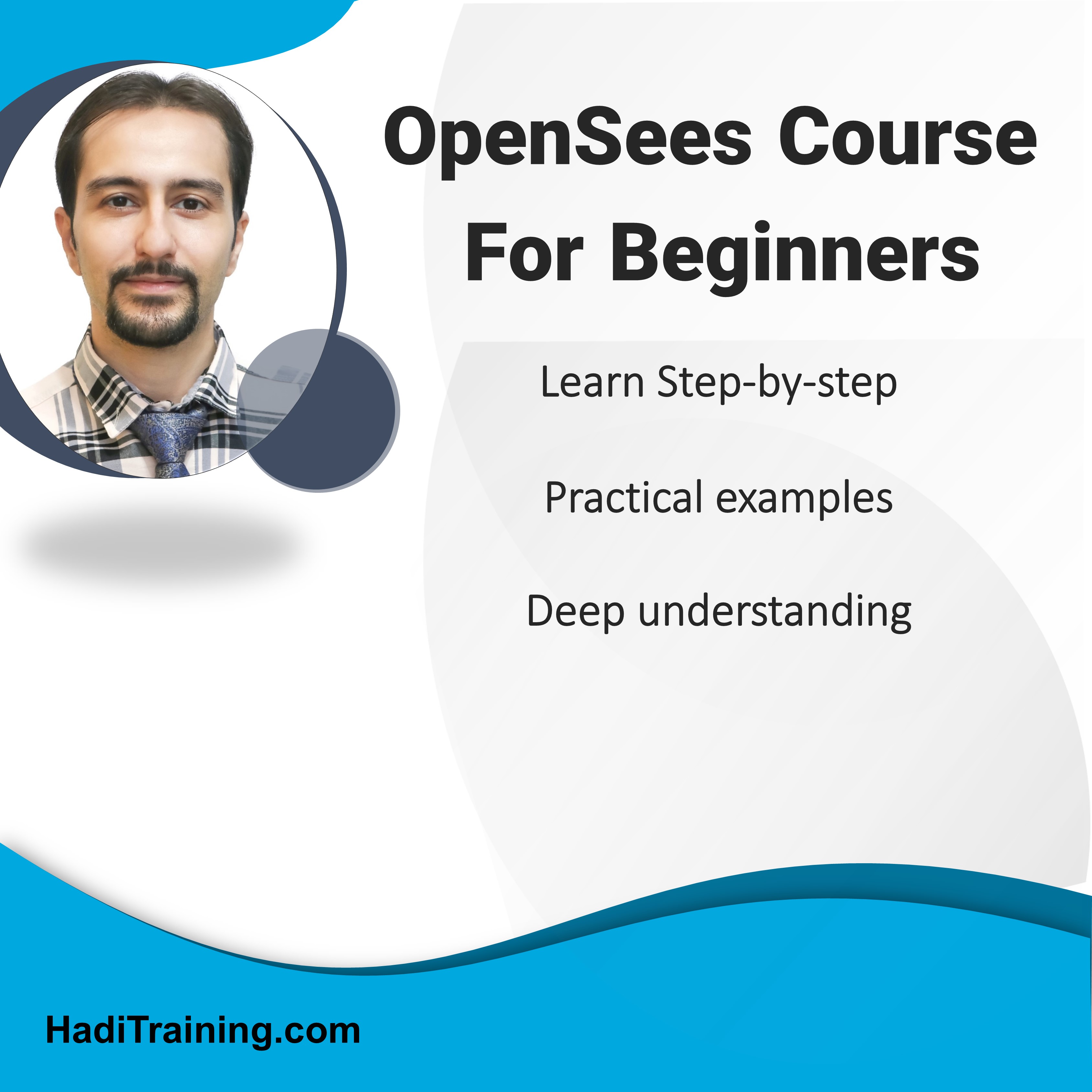
OpenSees Course For Beginners (Free)
-
Programming Language: Python
-
Duration: 2:20
-
Prerequisites: None
-
Language: English
-
Downloadable Resources: Yes
-
Q&A Support: No
-
Instructor: Hadi Eslamnia
-
Access: Yes
Price:
$0About Course:
This advanced training program offers a systematic, application-oriented introduction to OpenSeesPy, the Python interface for OpenSees, designed specifically for structural and earthquake engineers. The course blends theoretical foundations with hands-on programming, nonlinear modeling, and validation techniques using authoritative references such as ATC 76-1 and ETABS.

Note that
This advanced training program offers a systematic, application-oriented introduction to OpenSeesPy, the Python interface for OpenSees, designed specifically for structural and earthquake engineers. The course blends theoretical foundations with hands-on programming, nonlinear modeling, and validation techniques using authoritative references such as ATC 76-1 and ETABS.
Key Learning Outcomes:
Comprehensive Training in Python Programming
In-depth Understanding of Nonlinear Structural Analysis and Modeling
Modeling of Steel and Concrete Structures with Connection Zones
Complete Implementation of a Steel Frame Structure Based on ATC 76-1, with Detailed Validation
Comprehensive Implementation of a Concrete Frame Structure
Validation of Steel Frame Pushover Analysis with ATC 76-1
Validation of Steel Structure Periods Using ATC 76-1 and ETABS
Validation of Concrete Structure Periods via ETABS, Including Key Modeling Considerations
Provision of Convergence Codes for Pushover, Cyclic, and Nonlinear Time History Analyses
Detailed Study of Key OpenSeesPy Elements: twoNodeLink, zeroLength, and truss
Automatic Tools and Custom Python Functions Included:
Automated definition of steel I-shaped and box sections
Automated definition of rectangular concrete sections
Automated implementation of connection zones using:
End-offset method
Rectangular zone
Scissors method
Automated modeling of nonlinear panel zones using the Krawinkler model
Conversion functions between displacement and drift
Quick section generation from property files
Longitudinal mesh generator for concrete elements to enhance accuracy
Convergence codes for pushover and time history analyses
Plotting utilities for automated and comparative visualization
Earthquake record import tools compatible with PEER and OpenSeesPy databases
Detailed Course Structure
Chapter 1: Installation and Setup
Installing OpenSeesPy in Anaconda
Environment setup with Spyder
Required Python libraries and configurations
Chapter 2: Python Programming for Engineers
Python basics, variables, data types, and control structures
Functions, arguments, loops, and logical conditions
Libraries: numpy, pandas, math
Working with arrays, matrices, and CSV files
Chapter 3: Introduction to OpenSeesPy
Overview of OpenSeesPy vs. ETABS vs. ABAQUS
Micro vs. macro modeling
Finite element process and its practical implications
Chapter 4: Basic Modeling and Linear Analysis
Unit systems, coordinate conventions
Cantilever beam modeling and static loading
Time series, visualization using opsvis
Elastic frame analysis and basic output interpretation
Chapter 5: Nonlinear Modeling of Steel Frames
Geometric and material nonlinearity
Fiber section modeling and material selection
forceBeamColumn vs. dispBeamColumn elements
Concepts of kinematic and isotropic hardening
Chapter 6: Pushover Analysis
Lateral loading patterns, convergence techniques
Base shear vs. weight plots
Automated post-processing and graphing utilities
Chapter 7: Visualization and Animation
Using OpsVis, VFO, and Brainery Wiz for model visualization
Modal shape animations and force diagrams
Chapter 8: Nonlinear Panel Zone Behavior
Modeling strategies: Krawinkler, Scissors, Rectangular, Cross
Code templates for nonlinear connection zones
Panel zone behavior under cyclic loading
Chapter 9: Nonlinear Time History Analysis
Newmark method, Rayleigh damping, and record processing
Time integration, output interpretation, convergence tools
PEER ground motion records and structural response animation
Chapter 10: Output Extraction Techniques
Displacement, acceleration, eigenvalues
Local/global force outputs, fiber stress-strain data
Recorder setup for analysis tracking
Chapter 11: Nonlinear Modeling of Concrete Frames
Concrete section modeling using fiber method
Confined/unconfined concrete zones
Longitudinal reinforcement detailing and meshing
Output interpretation and ETABS period validation
Chapter 12: Key OpenSeesPy Elements
zeroLength, twoNodeLink, and truss elements
Joint modeling strategies and degrees of freedom handling
Chapter 13: Leaning Column Modeling
P-Delta effects due to gravity columns
Implementation of leaning columns in 2D/3D models
Chapter 14: Nonlinear Behavior and Deterioration
Damage models and degradation modes for steel and concrete
Concentrated plastic hinge vs. fiber modeling: pros and cons
Advanced Projects
Project 1: Steel Frame System Based on ATC-76-1
Full automation of geometry, material, and section definitions
Nonlinear panel zones, gravity load application, and leaning columns
Pushover analysis, time history simulation, and period validation via ETABS
Output comparison with ATC benchmarks and parameter sensitivity studies
Project 2: Concrete Frame System
Automated modeling from section data files
Longitudinal meshing, pushover, and time history analyses
Comparison of model assumptions and period matching with ETABS
This course is ideal for graduate students, researchers, and practicing engineers who seek a deep understanding of nonlinear structural modeling and simulation using OpenSeesPy. All examples are based on real-world projects and validated using established references in structural earthquake engineering.
Course Chapters

Introduction and install opensees
20:00

Introduction to OpenSees
4:00

Comparison of opensees etabs abaqus
5:00

Unit and coordinate system
4:00

install OpenSeesPy
7:00

Elastic cantilever beam example
00:00

Pushover on nonlinear frame
00:00
Leave a Comment: